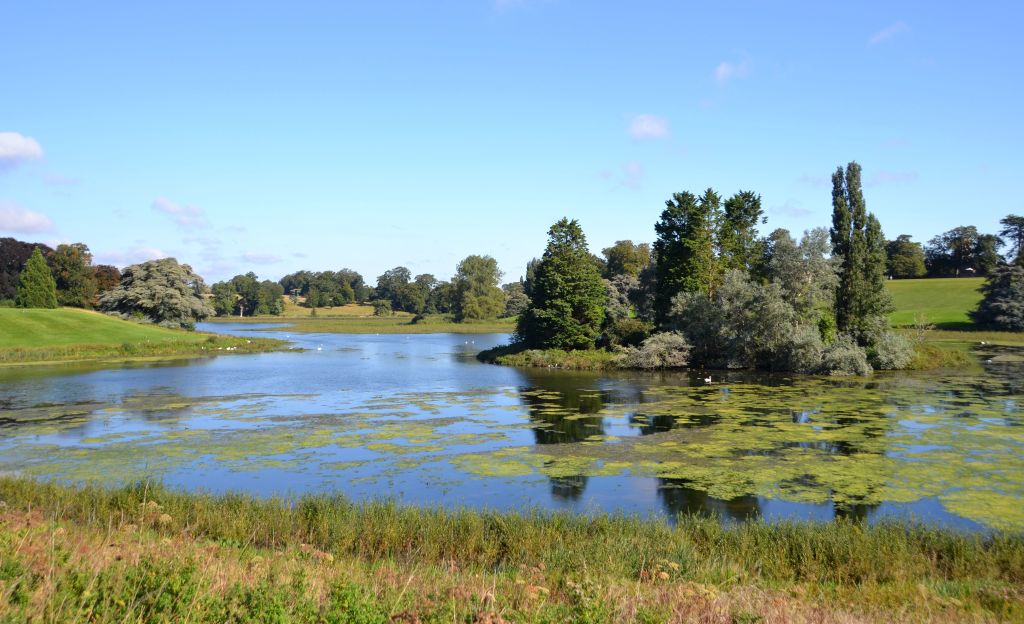This local item has provided some welcome motivation in the present autumn wind-down to the dreaded and detested dark season. A “probable” Purple Heron was first reported on Going Birding from Blenheim Palace’s grand water features on 14th September, then again two days later. That prompted my ever restless birding colleague Ewan to make an early conversion on Friday 17th (see here), and in contact with him I visited a little later on the same morning.
Ewan and another birder had located this juvenile wanderer in Willow scrub along one shore of the estate’s Queen Pool (SP440164). Having moved on he had asked his fellow to wait for myself and other Oxon birders to arrive. But as I approached there, two disappointed departees told me my quest had been chased off by Grey Herons onto the adjacent Lake. Another phone call revealed the likely viewing point and so I joined several birders scanning a particular area of reeds on the far side of Capability Brown’s watery creation.
Cue a patient wait for something to flush what is a notoriously skulking large bird. Horse riders were visible through the cover beyond and fly-by Grey Herons were also willed by all present to shorten our sojourn. Eventually a commotion between two Mute Swans erupted close to the area under scrutiny. The consensus was they were getting it on and fortunately their ardour spilled over into the part of the reed bed we were all watching. How fortunate!
Yes, up then indeed popped a very brown-toned Heron that perched in a lakeside tree for a few minutes before flying off to the far end of The Lake. Thus I had observed my third national Purple Heron; the others, both autumn juveniles having been at RSPB Ouse Washes (1997) and RSPB Otmoor (2016). I remained in position for the rest of the morning without viewing the Blenheim bird again, and it was not reported subsequently until early evening.
The weekend was the occasion of the Blenheim International Horse Trials so was not a good time for on-site birding. Some intrepid Oxon birders nonetheless connected again early on Sunday (see here). Having endured a motivationally low weekend I now elected for an early start of my own, returning at 7:30 am on Monday 20th. On arrival I found myself at first to be the only birder present, then scanned the margins of both water features without success as well as tall trees on the island in Queen Pool. First impressions were of looking more or less directly into the rising sun, which didn’t help.
Having arranged to meet another of my more regular wildlife colleagues Sally, when the phone next rang she was heading for a picnic area on the far side of Queen Pool. Rendezvousing there we found the best possible vantage point to watch both the island and margins and so time progressed as we settled in and waited patiently. Shortly before 9am a brown looking Heron flew in from one side then over us to land on the far shore to one side of the Grand Bridge (pictured above). And so, stopping my talkative companion in full flow I announced: “That’s it!” Cue a pre-agreed call to other on-site Oxon birders who could not yet see it and the Purple Heron was re-announced to the airwaves.

Through the next hour this county and national scarcity offered very good value as mostly showing well it foraged in the marginal vegetation (above). Achieving adequate pictures at the distance was hardly likely though, but those herein convey how this bird was seen by myself and so must suffice. The juvenile bird’s onward path took it ever closer to a largish group of Mute Swans (below) and so we waited for the inevitable to happen. Sure enough the resident Swans took exception to the interloper and went into the threat posture, at which the Purple Heron took off and flew to the opposite shore, and so we followed.
More birders and interested general public gathered round as we then watched the Purple Heron’s neck and head moving and foraging through deeper cover (see here). There seemed little reason for the bird to re-locate from there unless it was spooked by something, and so in late morning we went on our separate ways. This Oxon rarity had without doubt put on its best show to date this morning. It was one of a small September influx nationally with other individuals occurring in Norfolk, Essex, West Sussex, Kent and Somerset.
Recent “neglect” of the Blenheim lake margins has undoubtedly enhanced their quality as wildlife habitat, which is currently evidenced by the presence of five different Heron species in the park. Earlier this year Cattle Egret bred in Oxfordshire for the first time ever in the island heronry and Great White Egret are regular at the site in autumn and winter. But Queen Pool is due to be drained and dredged soon, the work having been postponed through the Covid pandemic, so how the “wildlife friendliness” here may then be affected remains to be seen. Right now I just feel pleased to enjoy the situation while it lasts.








